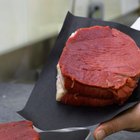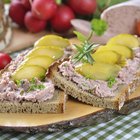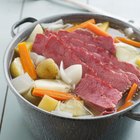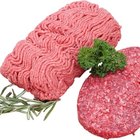Camrocker/iStock/GettyImages
Originally referring to a meat preservation technique, the word "pastrami" shares Romanian, Yiddish and Turkish roots. Today, a call for "pastrami" at most local U.S. delis will get you a tasty sandwich; in New York City, the meat is considered an icon of the local food scene. Although traditional curing methods are no longer necessary for food preservation, pastrami-making remains one of the tastiest uses for tough cuts such as brisket.
History of Pastrami
Traditionally, the cheapest cuts of lamb, mutton, or pork were made into pastrami. The meat was rubbed with salt and spices, then wind-dried and occasionally cold-smoked until adequately preserved. The method that Romanian Jews brought to New York in the late 19th century evolved into the beef pastrami sandwich served throughout North America today.
Preparing the Meat
Brining the meat in a salt solution is the first step in pastrami preparation. Alternatively, some methods specify a dry rub instead of a wet brine. Nitrate-containing curing salt, not the type of meat, causes the pink hue typically associated with pastrami. Next, the meat is coated with a spice mixture and smoked until tender. Depending on the cut of meat, some recipes call for subsequent steaming to further break down connective tissues. The meat is thinly sliced against the grain to serve.
Beef Pastrami
Although modern pastrami technique varies from the original Romanian process, New York pastrami has not changed since the late 19th century. The famous pastrami served in New York delis is made from the navel end of the beef brisket, known as the plate cut. This is a popular cut for pastrami-making as it is considered kosher, since it comes from the front quarters of the cow. Beef brisket, round and short rib cuts are also commonly made into pastrami.
Other Pastramis
You can make pastrami out of any meat, including turkey, chicken, goose, lamb, goat, venison and veal. Some restaurants are even bucking the kosher tradition by making pastrami from cuts of pork. Especially lean meats lend themselves well to pastrami because the long curing and cooking process breaks down tough muscle fibers. Today, you can even buy vegetarian pastrami made from soy or wheat flour.
Related Articles

Types of Corned Beef

Different Kinds of Lunch Meat

The Best Way to Prepare Bison Sirloin

How to Make Dried Meat

How to Cook Angus Beef Steak

Different Cuts of Steak

What Is Liverwurst Made Out Of?

How to Slice Round Steak for Jerky

How Long Will Dry Salami Last if Not ...

How to Barbecue Bologna on a Charcoal ...

How to Pickle Beef Brisket

What Type of Meat Do They Use to Make ...

List of Cuban Foods

What Is a Picnic Roast?

What Is Hog Casing Made Of?

What Cuts of Meat Are Used for Ground ...

How to Salt Cure Jerky

How to Cook Tender Rolled Flank Steaks ...

How to Smoke Sausage in a Meat Smoker

How to Cook a 1 1/2 Lbs Corned Beef ...
References
Writer Bio
Instilled by a passion for all things food, Eric Lissner began food writing in 2011 while studying Civil Engineering at UCLA. After graduating summa cum laude, he began his engineering career while pursing writing on his personal blog.